Each month V.D. Kaviraj will answer questions about plants and plant problems. Kaviraj is one of the foremost pioneers of Agro-homeopathy and author of the book, Homeopathy for Farm and Garden.
Send your questions with pictures when possible (JPG or GIF format) to [email protected] with the subject “Plant Doctor”.
Note: When I refer to treating plants with homeopathic remedies, this is the standard dosing procedure: Put 20 drops of a 6X potency in a litre of water. Succuss the bottle 50 times. Put this litre in the watering can, fill it up with 19 litres of tap water and stir. If the watering can is smaller, the amount of remedy put in must be proportionally smaller. Thus a 10 litre can needs only ½ litre and just 10 drops of the remedy. Apply the contents of the watering can to the roots of the plants to be treated.
VD Kaviraj has just returned from teaching agrohomeopathy in Bharat, India. He is working with university professors who have a model farm on the campus. Many also come to his student who has been running her own clinic for about eight months.
Dear Dr. Kaviraj,
Recently I discovered your website. I am reading your articles with much interest and did several treatments with good results. I have a tremendous problem: A beautiful Laurier tree, in front of our house, was trimmed by the gardner 3 weeks ago and now all the new offspring are full of insects and drying up. This tree had never problems during 30 years we are living here. How can I help this tree?
Some months ago I bought an electronic vibro-potentizer from Bruce Copen in England, so I can make every potency I need for the treatments. Is your book available in other languages than English?
Henriette Bonda
Dear Henrietta,
This is woolly aphid, (wolluis). To treat it, make Coccinella 6x on your machine and give the remedy as I describe at the top of this column.
My book is in English, but a better version exists in German, if you can read that. Available from www.narayana-verlag.de
Hi Dr. Kaviraj,
As you are aware, there is a huge threat to the Ash trees in the Midwest of the United States which is the Emerald Ash Borer. Currently there is only one proven remedy which of course is a pharmaceutical agent which is expensive and a short-term solution. What suggestions do you have for this? Thank you for your great work.
Patrick
Hi Patrick,
Borers and other insects that are not on the surface can be counteracted by Thuja, always in the 6X potency, as described at the top of this column. Of course the Agribusinesses have nothing but chemical poisons, which is probably one of the reasons for other problems, such as fungi in chestnuts and maple dieback in Europe. Here some photos of the results of Thuja on trees infested with gallwasp, so that you can see what Thuja can do.
Before treatment showing Gallwasps
Healthy trees after treatment with Thuja
Dear Plant Doctor,
Could you help me understand what disease my soybeans are suffering from, and whether they’re still edible? The pods look like photos I’ve seen of pod and stem blight, but I don’t see any of the black fruiting bodies that are described. The leaves and stems seem mostly normal (a little purplish speckling on some leaves),
it’s just that the pods are turning brown, and the seeds inside look fine. It does look like the tops of the plants have fallen off, and some stems are brown, but no black spots. Thank you so much for your time!
Sincerely,
Jennifer Eckard
Dear Jennifer,
That disease looks like something that plagued the soy in Australia 10 years back, when I was there. To me it appears like Silicea is the remedy.
On the other hand, when soy ripens, the pods turn brown and dry up and the seeds inside stay green. I would not eat soy though, because humans miss the enzyme to digest soy. In Ayurveda it is said to be food for pigs and it has always been an animal feed till some smartass said it was fit for humans and prevents osteoporosis. This myth has been perpetuated by Agribusiness and now they mix it in bread and make so-called soy-milk out of it.
The Chinese know it is not a human food unless fermented with lactic acid and turned into bean curd known as tofu. Then humans can digest it, but the nutritional value is minimal, because the proteins are not fully assimilated.
Dear Kaviraj,
Thank you for your wonderful work. Can you recommend any remedies for Alfalfa Mosaic Virus?
Thank you
Celia Dalton
Dear Celia,
Alfalfa mosaic can be combated by Salicylic acid. Tests done at several agricultural research centres have shown that such is the best remedy.
Kaviraj

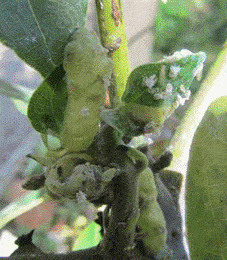

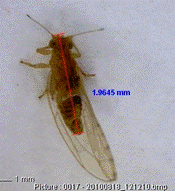
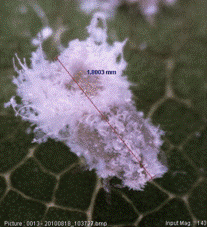
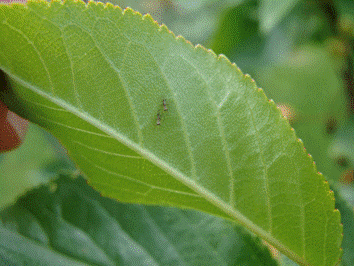
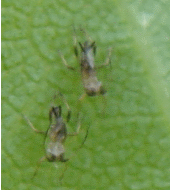

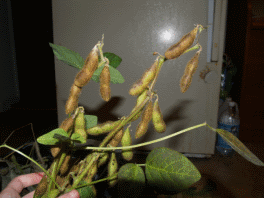
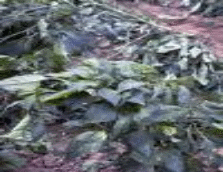
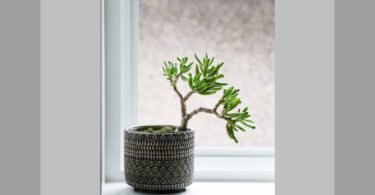
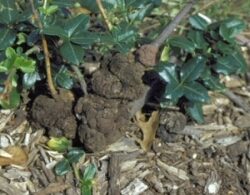


I would like to know is there any homeo treatment for Mileey bug which affects the plants especially hibiscus. I would also like to the name of some good books for diseases of animals especially pet animals/household animals and garden plants mainly of tropical region. I am living in India. thanks and regards.
Hi Renuka,
mealy bug can be combated with Coccinella, in the manner described at the top of the page. The best book on this subject is Homoeopathy for Farm and Garden. Available from http://www.considera.co.uk or http://www.narayana-verlag.de
Books on animals can be had from B.Jain Publishers in New Delhi. McLeod has several titles on cows, sheep and horses, while Christopher Day also wrote some.
Dear Sir,
Please suggest a remedy for GALL INSECT (Leptocybe invasa, a tiny wasp measuring 1.1 to 1.4 mm) PROBLEM IN EUCALYPTUS.
Best Regards
Vineet Pundir
Above you see a photo of the galwasp problem and the remedy used to cure it – Thuja occidentalis. As the photos show, the galls are the sed bubbles on the leaves. We shall ask Alan Schmukler, the editor, if next time he can show how the leaves look after treatment.
what can be done about root knot nematodes?
Root knot Nematodes can be gotten rid of by Clendula, Cina, or Staphysagria. Do not use more than one remedy at a time. Do not repeat before 3 months have passed.
Kaviraj posted:”I would not eat soy though, because humans miss the enzyme to digest soy. In Ayurveda it is said to be food for pigs and it has always been an animal feed till some smartass said it was fit for humans and prevents osteoporosis. This myth has been perpetuated by Agribusiness and now they mix it in bread and make so-called soy-milk out of it……………….”
Glad you mentioned this,many consumers cannot eat drink soy products including myself. I get the worst stomach pains if i do.
The link between soy and osteoperosis is at best tenuous. It is really agribusiness promoting the sale of their pig food to humans.
Dear Dr.V.D.Kaviraj,
I am interested in Agrohomeopathy in Tamilnadu, (India), your research medicine not available in india any homeopathy producers, Please help to the Silicea 6x dilution easily available in india,
please kind one distributor your selected and supply the Agro homeopathy Books and medicines,
Thank you,
Yours loving evers,
Thiyagarajan
Salem – Tamilnadu
You can order the reedies from any good homoeopathic shop. They should have any remedy in the 6X potency.
My book is available in Tamil from Dr Abdul Lethif in Kerala.
His email is [email protected]
He may also have the remedies.
My research remedies are available everywhere in India. I just returned from there and had no difficulties at all. If you cannot find them, order from Bandhari in New Delhi or from Dr Abdul Lethif in Kerala. See for email your other post.
Dear Dr. I am contact, email to Dr.Abdul Lathif, Kerala, your books not availed himself, My interesting is first read of your all Agro-homeopathy books.
Awaiting yours kind help
Silkworm eat mulberry leaves, papaya mealy bug (Paracoccus marginatus) infestation is more in mulberry other plants, please help the Tamilnadu (India) sericulture farmers to prevent the infestation of mealy bug, coccinella 6x to control the papaya mealy bug? please reply the suggestion? and how to apply the remedy? nearly 10000 farmers practicing sericulture,
thiyagarajan,
[email protected]
Yes, Coccinella will control the mealy bug.
How to apply the remedies is explained at the top of the page. Rates, amount of succussions and application are all explained.
Thank you, your reply and suggestions,
If Dr Lethif says that, then he did not translate my book in Tamil, although he asked permission from me even before it was published. He wanted to do in Tamil, Malayalam, Telugu, Kannada and Hindi. I wonder what happened.
Better then you order the English version from http://www.considera.co.uk
What do you mean potency 6x? 6 CH Does he?
What do I mean? 6X is the 6th decimal potency. 6Ch id the 6th centisemal potency. 6X has as many dilutions as 3CH, but two times as many succussions. Plants like the 6X or D6 better.
thanks a lot